
Brief Update No 25/14 Date: 25 June 2025
STATEMENT
This document has been approved for distribution by Sea Guardian S.G Ltd / Operations Department. The provided Intel and Information derive from open sources, the Institute for the Study of War (ISW), the Joint Maritime Information Center (JMIC) and United Kingdom Maritime Trade Operations (UKMTO), respective Web Pages and products retrofit the company’s Strategic / Operational and Security situational awareness processes for risks and threat assessment/impact to the Security of Maritime operations. All rights reserved, “no part of this Risk assessment may be reproduced in an form (electronical, mechanical, paper or other means) without written permission by Sea Guardian SG Ltd” which maintain the rights for personal data of this document writers. Under no Circumstances can Sea Guardian SG Ltd be held responsible for any loss or damage caused by a reader’s reliance on information obtained by this Assessment, especially on its firms, company’s management or individual decision-making.
Objectives
- The purpose of this brief is to provide periodically, in a 15-day cycle, the maritime industry and Security Stakeholders or Shareholders with:
- Major maritime security incident summary and analysis in Geo-strategic frame for Operational Security and Security of shipping for the period 13-25 June 2025.
- Threat assessment updates concerning military operations – terrorism – piracy and also cargo theft, smuggling, stowaways, ships fired and crew loses.
- Overview of risk assessment and relevant information, in order to support operational planning and decision as well as the needs for assuredness (impact for insurance or Special security needs) after threats and risks Analysis.
- Sea-guardian, pursuing the innovative approach by analyzing the Maritime Security not only in accordance with international standards procedures but also in the certain frame of Geo-policy as its Security assessment deals with not only with the risks but also with the threats and International Security “gaps” maintaining well informed its clients’ concerns.
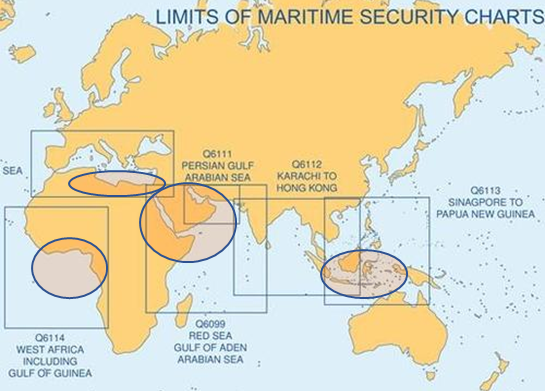
Risk Management | Sea Guardian Ltd Security Consultancy | Sea Guardian Ltd
RECENT KEY DEVELOPMENTS
- On June 13, it was revealed that a new front in Sudan’s civil war has erupted on the desert border between Sudan, Libya, and Egypt for the first time since the outbreak of armed conflict in Khartoum, raising fears of direct regional confrontations in the region. Confrontations began to take shape following the Sudanese army’s accusation that the Libyan National Army (LNA), led by General Khalifa Haftar, had infiltrated the Sudanese border and attacked its forces, a claim denied by the latter.
- On June 13,it is stated by ISS that the sharing of lethal drone technology with al-Shabaab and IS Somalia could recast the conflict in the Horn of Africa and beyond. Yemen’s Ansar Allah – commonly known as the Houthis – and Somalia’s two proscribed terrorist organizations, al-Shabaab and Islamic State in Somalia (IS Somalia), are reportedly deepening ties. Al-Shabaab has to date used drones largely for propaganda, intelligence and surveillance rather than attacks. UN monitors describe its relationship with Ansar Allah as ‘transactional or opportunistic’ – the pair having shared interests in smuggling routes and access to revenue streams.
- On June 14, following the assassination of top Iranian military leaders in Israel’s strike, Iran’s Commander-in-Chief Ayatollah Seyyed Ali Khamenei has announced major appointments to restructure the country’s military leadership. According to Iranian state-run media IRNA, Major General Amir Hatami has been appointed as the Chief Commander of the Army of the Islamic Republic of Iran, having served from 2013 to 2021 as Iran’s Defense Minister. In his official decree, Khamenei praised Hatami’s “dedication, competence, and experience,” and called for a “transformative and revolutionary approach” under his leadership, IRNA in its report said.
- On June 15, French President Emmanuel Macron has arrived in Greenland with a “message of solidarity and friendship” from Europe and castigated United States President Donald Trump’s repeated threats that he intends to take control of the strategic autonomous Danish territory as not “something to be done between allies”.
- On June 15, an analysis by Geopolitical monitor came up statedthat Israel’s Endgame in Iran: is Collapse, Not Containment. This strategic logic is a direct outgrowth of the Begin Doctrine, first articulated in the early 1980s, which asserts that Israel will not allow hostile states in the region to acquire nuclear weapons. Initially applied in discrete surgical operations (such as the 1981 airstrike on Iraq’s Osirak reactor and the 2007 bombing of Syria’s Al-Kibar facility), the doctrine has, under Netanyahu, evolved into a far more expansive framework. What was once an operational guideline to prevent technical nuclear capability has become a programmatic approach to strategic denial.
- On June 15, thousands of protesters gathered in Ivory Coast ‘s capital Abidjan to demand the reinstatement on the electoral list of main opposition leader Tidjane Thiam, a former CEO of Credit Suisse, who was barred from running in the presidential election set for October 2025. Despite heavy rain, protesters peacefully gathered near the independent electoral commission, the body responsible for organizing the vote, in Abidjan.
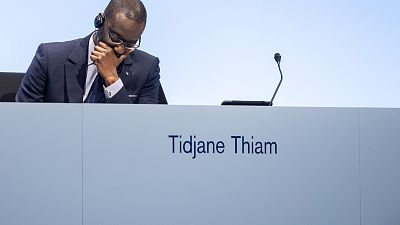
- On June 16, Kenya’s Government Spokesperson Dr. Isaac Mwaura has come out to dispel reports that Kenya is involved as an architect in the Sudan war. Speaking to the press on Monday, Mwaura clarified that Kenya is only involved in the war from a diplomatic standpoint, acting as a mediator between warring factions in Sudan to achieve a ceasefire.
- On June 16, it was revealed that the US ban list on entrance to the US is expanded. If implemented, the new measures would mean nearly 40 African countries face bans or some form of travel restrictions to the United States. An internal State Department cable cites reasons such as unreliable identity documents, passport security and the refusal or unwillingness by some countries to receive deported nationals, Reuters reported. Other grounds listed in the cable are terrorism, involvement in antisemitic and anti-American activity. Over all, the document names twelve grounds to threaten travel restrictions against 36 countries in total. The list includes major US partners in Africa such as Kenya, Angola, Egypt, Ethiopia, Ivory Coast and Nigeria.
- On June 17, Ethiopia’s National Rehabilitation Commission disclosed that more than 56,000 former combatants have been demobilized and successfully reinserted into their communities across four regions to date. Over 45,000 of the combatants are from Tigray region of Ethiopia. National Rehabilitation Commission convened its regular Program Implementation Review Meeting with the DDR Partners Task Force today.
- On June 17, it was published that the Israeli army bulldozed on Tuesday 15 homes in the northern countryside of Quneitra, southern Syria, for being too close to a military outpost recently established in the area. Local sources told North Press that the demolition took place in the town of al-Hamidiyah, with the army justifying the action as necessary to expand the security perimeter of its military position.


- On June 17,the Central Bank of Libya (CBL) has announced the withdrawal of several old banknote issues from circulation, based on decisions issued by its Board of Directors during a meeting held on June 16, 2025.The CBL clarified that the decision includes withdrawing the 20-dinar banknotes, 5-dinar banknotes, and 1-dinar banknotes. According to the statement, the implementation of these decisions will begin at the end of the working day on June 17, 2025. The final deadline for accepting the withdrawn banknotes at banks and their branches is the end of the working day on September 30, 2025.

On June 19, Nigeria’s President Bola Tinubu directed security agencies to hunt down the perpetrators of a weekend attack that killed at least 150 people in the country’s northcentral, as he faces growing pressure over a worsening security crisis. Tinubu visited Benue State, the site of the recent deadly attacks, seeking to calm tensions and promise justice for the victims. “We will restore peace, rebuild, and bring the perpetrators to justice. You are not alone,” the Nigerian leader said on X.
On June 19, Donald Trump has approved plans to attack Iran, but has not made a final decision on whether to use them, the BBC’s US partner CBS reports. The US president held off from strikes in case Iran agreed to abandon its nuclear program, an intelligence source said. Trump is reportedly considering strikes on the underground uranium enrichment facility at Fordo.
On June 19, IMO has said there were no indications of any increased threat to shipping in the Arabian Gulf, despite Iranian calls for international measures to prevent escalation in the Strait of Hormuz. Speaking at the IMO’s annual safety meeting on Wednesday 18th, secretary Arsenio Dominguez said no signs of closure or disruption had appeared yet. “We’re not at that stage,” he said, answering a question from The National.
On June 19, it is stated that the collision between two oil tankers just east of the world’s most critical oil choke point, the Strait of Hormuz, could bring about a potential environmental disaster, Greenpeace said. The two giant tankers, ADALYNN and FRONT EAGLE, crashed Tuesday 17th in the Gulf of Oman and caught fire before the Emirati national guard intervened to evacuate crew members. No injuries were reported, according to Emirati authorities. Satellite data from NASA’s Fire Information for Resource Management System showed heat signatures in the area early Tuesday morning. Greenpeace said it had reviewed satellite imagery that showed a plume of oil stretching up to about 1,500 hectares (3,700 acres) from the crash site. The 23-year-old tanker ADALYNN belonged to a so-called Russian “shadow fleet” – known to operate older ships below basic security standards – and may have been carrying around 70,000 tons of crude oil, the group said.
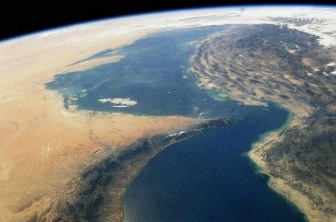
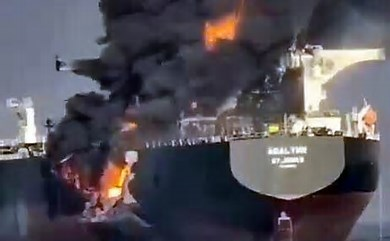
- On June 20, more than 200 gunmen on motorbikes have attacked a Niger army base near the border with Mali, leaving at least 34 soldiers dead, the country’s defense ministry said. The attackers – described by the ministry as “mercenaries” – raided the base in the western town of Banibangou on Thursday, injuring 14 other soldiers. The ministry said that its forces killed “dozens of terrorists” in the battle. Niger’s military is under pressure for failing to curb militant attacks, one of its justifications for deposing democratically elected President Mohamed Bazoum in 2023.
- On June 20, SCA stated that CMA CGM “box ship” has become the first large vessel to pass through the Suez Canal in 15 months, according to Ossama Rabiee, chairman of the Suez Canal Authority (SCA). On June 18, the 15,536-teu CMA CGM Osiris (built 2021) was part of a convoy heading to Alexandria Egypt from Singapore, at a time of heightened tensions in the Middle East. The SCA said this was the first such voyage from the Bab el-Mandeb strait since March 2024, referring to Houthi attacks on shipping as “regional challenges”. The transit also marks the culmination of the marketing effort.
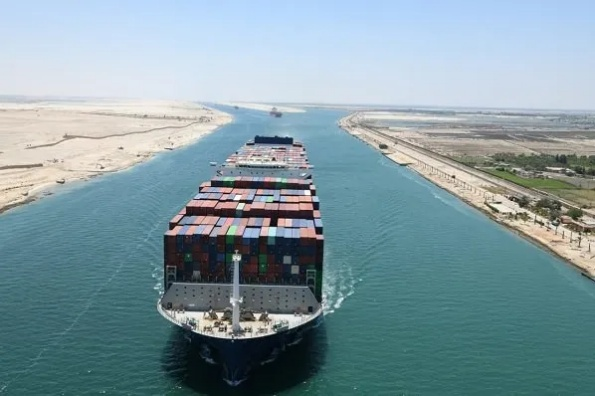
- On June 20, it was published that marine insurers are now charging 0.2% of a ship’s value for voyages into the Gulf, up from 0.125% before Israel’s surprise attack on Iran last week, CNBC reports based on data from insurance broker Marsh McLennan. In addition, war risk insurance rates for the Red Sea have risen and coverage for ports in Israel has surged more than threefold, reaching 0.7%. Marsh data, also noted that the validity period for insurance quotes has been halved, dropping from 48 hours to just 24, as underwriters move quickly to reassess risks in an increasingly volatile environment.
- On June 21, Niger’s military junta says it will nationalize the majority French-owned local uranium company, in the latest escalation in a row between the two countries. Somaïr is operated by French nuclear fuels company Orano, which Niger accuses of several “irresponsible acts”. Since seizing power in 2023, Niger’s military leaders have said they want to keep more local control of the country’s mineral wealth, and have distanced themselves from France, the former colonial power, moving closer to Russia.

- On June 22, the U.S. State Department issued an official order for the departure of non-emergency government personnel and their family members from Lebanon, citing heightened security concerns in the region. The decision was communicated to American citizens currently residing in Lebanon via email, as the State Department warned of a “volatile security environment” in light of the ongoing regional developments.
- On June 23, three police officers in Kenya have been charged with the murder of a 31-year-old blogger who died in police custody earlier this month. Albert Ojwang’s death has sparked outrage in Kenya with protests held to demand justice. Mr Ojwang was arrested after Kenya’s deputy police chief Eliud Lagat filed a complaint, accusing the blogger of defaming him on social media. Mr Lagat stepped aside last week pending the outcome of investigations into Ojwang’s death. He has denied any wrongdoing.
- On June 23, US Secretary of State Marco Rubio has called on China to prevent Iran from closing the Strait of Hormuz, one of the world’s most important shipping routes. His comments came after Iran’s state-run Press TV reported that parliament had approved a plan to close the Strait but added that the final decision lies with the Supreme National Security Council. Any disruption to the supply of oil would have profound consequences for the economy. China in particular is the world’s largest buyer of Iranian oil and has a close relationship with Tehran.
- On June 24, Israel and Iran entered into a shaky ceasefire Tuesday morning, bringing an uncertain end to the 12 days of fighting having sparked fears of regional war. The ceasefire appeared to be in trouble within hours of both sides acknowledging its start, as Israel said Tehran fired another wave of missiles, sounding sirens across northern Israel. After that Israeli Defense Minister Israel Katz said he instructed the military to “respond forcefully to Iran’s violation of the ceasefire”. The same day, mid-day hours U.S. President Donald Trump told Israel, “Do not drop those bombs” on Iran, hours after he had said a ceasefire between the two arch-foes had taken effect. “ISRAEL DO NOT DROP THOSE BOMBS”, Trump said on his Truth Social platform. “IF YOU DO IT IS A MAJOR VIOLATION. BRING YOUR PILOTS HOME, NOW!”
THE GEOPOLITICAL PROFILES & INTERNATIONAL SECURITY
- GEO-political / Geo-Strategic profile: The semi-annual profile assessment has been set on the previous SEAGUARDIAN Security Assessment 25/13, June 13, thus we assume that no changes are going to be inserted in the global Geo-policy arena. What even it would be the outcome of Israel-Iran conflict it will influence the change of countries’ leadership and Strategic issues but not the Geo-policy zones.
- Geopolitics / Geo-economics Profile: The pilar of Geo-economy is diversified for the two zones by EU and China who both pursues the Economic leadership position, so far. For details see the previous SEAGUARDIAN SECURITY ASSESSMENT of June 13 / Geopolitics / Geo-economics profile, in the related section (semi-annual review).

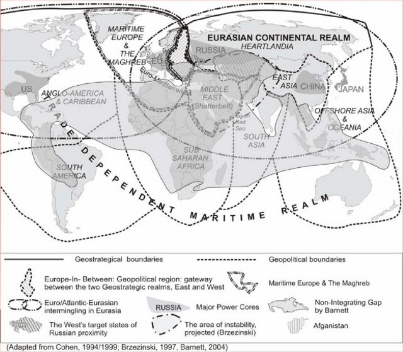
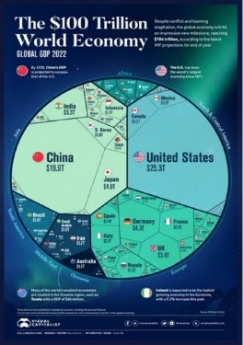
- International Security / Strategic sector: Usually in these cases considering the current situation, Maritime Industry tends to trust domestic or regionally relevant security services as for example it prefers a Western Security company fully recognized to ask for services than a Chinese, which sometimes is difficult to review its standards and location.
- Global Maritime Security profile: The Maritime industry is assumed that is threatened more by “military or paramilitary actions”, avoiding sailing through the Suez-canal and the Red Sea. In practice, military attacks like Houthis’ actions against merchant vessels crossing the Bab-el-Mandeb straight, have to be reported earlier than January 2025. Additionally, there are no reports for military actions in the Persian Gulf. It has to be considered that a sudden rise of criminality in “hot spot” areas cannot be undermined or excluded, as such actions could be fueled by State or non-state actors in order to achieve political of communicative objectives.
MARITIME SECURITY INCIDENTS: 14 – 25 June 251
| INCIDENT No | INCIDENT Type | INCIDENT TIME | INCIDENT DETAILS |
| 23 | Incidents – Advisory | 16 June | UKMTO has received multiple reports and monitoring of AIS confirms, that there is increasing electronic interference within the waters of the Persian Gulf and Straits of Hormuz. Whilst the level of electronic interference continues to rise across the wider region, the levels and intensity inside the Gulf are having a significant impact on vessels positional reporting through automated systems (AIS). Vessels are advised to transit with caution and continue to report incidents of electronic interference to the UKMTO. |
| 24 | Incidents – Advisory | 17 June | UKMTO has received a report of an incident involving a collision between two vessels 26NM North East of Fujairah, on June 16. There is no indication that this incident is the result of hostile activity resulting from the ongoing regional conflict. Local authorities are dealing with the incident. Vessels are advised to transit with caution and report any suspicious activity to UKMTO. |
1 In accordance to JMIC and/or UKMTO sources


THREAT ASSESSMENT UPDATE:
Military operations – terrorism – piracy and also cargo theft, smuggling, stowaways
Military Operations
Libya – Central Mediterranean

- It is estimated that the absence of a unified Strategic Plan for the next day of Libya not including its entire territory, in combination with the rivalry create conditions, are deepening the gap. For more detailed updates, you may look to SEAGUARDIAN SECURITY ASSESSMENT SG LTD 13 June 2025 / Military Operations / Libya.
- In the recent weeks, clashes among Haftar’s units, Sudanese forces and Egyptian border guards have been reported on the Northwestern border of Sudan, giving the impression that the Benghazi government is seeking not only to control the oilfields and ports of Eastern Libya, but also to establish its presence as an official force in the region while the internal competition in Libya is maintained.
- A new situation arises concerning conflicts in the borders of Libya with Sudan and Egypt.
- The threat assessment due to “military actions” is MEDIUM.
Syria
- It is estimated that President al-Sarrah will not react to Israel’s pursuit of decolonizing the borders of Southern Syria, destroying homes located near its border.
- Although no information has been publicly made about an agreement with the Alawites and non-SNF Druze concerning their political integration into the structure of the new state, the areas of the Syrian coast in the Mediterranean are calm and in particular the cities of Latakia and Tartus are now considered low-risk ports for safe docking.
- For more detailed information about the initial situation in Syria, at the beginning of the current semester, see SEA GUARDIAN SG LTD SECURITY ASSESSMENT March 2025, while the previous SEAGUARDIAN SG LTD SECURITY ASSESSMENT May 2025, essentially captures the key points that created the conditions for the new page in the Syrian issue (the initial situation being captured in SEAGUARDIAN SG LTD SECURITY ASSESSMENT June 13, 2025).
- The security risk for commercial ships due to “military actions” is MEDIUM, as any conflict is not related to international actors, nor to any frontal conflict between Israel and Syria that simply concerns Israeli operations against specific groups on its northeast border.
Lebanon
• Following the withdrawal of the Israeli Armed Forces (IDF) from South Lebanon, with the exception of five specific key outposts, and the takeover of the positions previously held by the IDF by the Lebanese Armed Forces (LAF), Hezbollah’s military capabilities and means in Lebanon remain low and there are no signs of a resurgence. However, the low mutual trust between the Israeli and Lebanese governments related to the disarmament of Palestinians in host communities in the country and Israel’s pursuit of defeating Hezbollah to the end, maintain a factor of “uncertainty” for peace.
- Far from the general direction of US to its citizens to avoid staying in the Middle East addressed before June 13 (the day before the Israel attack on Iran), a new advice was sent to US citizens the previous week specifically for Lebanon, that they have to leave the area except of those that they are highly appropriate.
• It is estimated that in the medium-term Iran will not be able to engage in any actions in support of Hezbollah in Lebanon, although it had stated that it would reverse its support for it. In retrospect, Israel seems having paused its operations on the boarders of Lebanon (the triggers address that has just eliminate them due to the conflict with Iran). The situation will normalize quickly, in case of an agreement for the demilitarization of Hezbollah. The risks for European vessels in the region are directly related to the stabilization of Syria and the termination of Israeli operations in its northern territories (Syria-Lebanon).
- The threat assessment due to “military actions” is MEDIUM.
Gaza-Israel
- Israel seeks to extend its sovereignty in order to secure the release of all hostages and the complete demilitarization of the Gaza Strip. Hamas rejects the idea of disarmament and withdrawal from Gaza, using the hostages as leverage.
- The latest proposal for peace in the region, which includes the complete disarmament of Hamas, appears to have been deactivated, if not abandoned, while an unprecedented humanitarian crisis is ongoing. It is estimated that Israel will continue to seek the distribution of any humanitarian aid through facilities that it will provide itself, not allowing the operation of structures that are not fully under Israel’s control.
- After the attack on Iran, it is clear that Israel plans the total elimination of threats in the region, regardless of internal and international reactions. It is estimated that the risk of creating new threats from extremist actions in the future will not be eliminated, as the ferocity of war creates conditions of hatred and hostility.
- The threat assessment due to military actions is MEDIUM to HIGH.
Sudan-Eritrea–Ethiopia
- The current situation of “who controls what” is shown in the maps below:
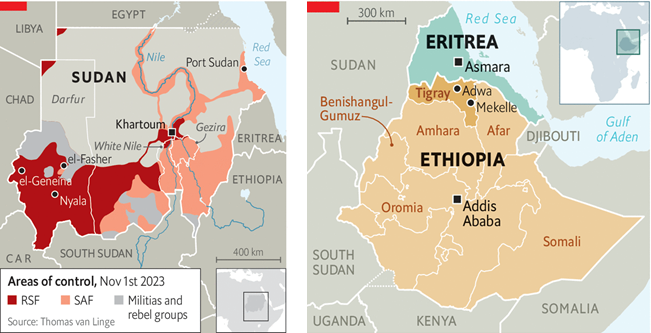
- The violent power struggle in the Tigray region, the recent attacks on humanitarian aid convoys in North Darfur, and the ongoing cholera epidemic, are intensifying the general state of “uncertainty” that could lead to the destabilization of the region.
- The resurgence of conflicts in the region has been continuous for the last two months. In addition, the clashes on the Libyan border with Haftar’s forces, Sudan and Egypt pose a threat to stability in the wider region. Recently, a government spokesman from Kenya denied his country’s involvement in the Sudanese civil war. On the other hand, there are also disarmament initiatives, such as Ethiopia’s in the Tigray region, where the numbers seem to be large.
- The threat assessment due to “military actions” returns to LOW from VERY LOW considering the ports security at the most, in the Red Sea.
Red Sea – Yemen
- The Houthis’ intention to stop harassing shipping remains even if the exchanging technology of drones with Somalia provide triggers for a new dimension of their threat (not only for the attacking on ships but also for piracy, at the most). Although they have not committed to stopping attacks on ships of American and Israeli interest, they have generally remained inactive since January 2025, while a possible attack could appear, suddenly. However, the US official involvement in the Israel-Iran conflict, is a trigger opening a wide spectrum of reactions from Iran, the Houthis and their supporting groups against US, Israel and their coalition’s partners.
- US, UK and EU naval forces are operating in the region, with the ability to strike targets on land, while since the previous two months, UK forces have also operated against Houthi.
- Israel also seems not to have stopped monitoring the issue and on the first ten days of this month carried out an operation against the Houthis with its Navy.
- Houthis overall intentions remained unclear but there are signs of maintaining close knit relations with Iran and the Somalian piracy groups.
• The threat assessment due to “military actions” is MEDIUM.
Israel – Iran / Northern Persian Gulf
- Israel launched airstrikes against Iran early morning hours on June 13, was the case the international community wished to avoid. The attack was part of the so called “Operation Rising Lion”, Israel’s PM Benjamin Netanyahu said, adding that Iran was an existential threat to “Israel’s very survival”. The importance of the attack itself is equal to the side-effect expected to be created, while it was shown that was just the beginning of a long-term operations period. At the time we write this report, countries denounced the attack openly are Saudi Arabia and Oman (which was a mediator to the negotiations between US and IRAN), while afterward Russia and China denounced it by declaring they will denounce it officially on the UN level, also.
- Israel has declared a state of emergency, saying the country expects counter-attacks “in the immediate future”. Iran has accused the US of supporting Israel’s attack, which US strongly denied. It appeared that Israel’s Strategic Plan for the disarmament of Iran has existed since 1980, which provided that “Israel will not allow Iran to acquire nuclear weapons”. Eventually, Netanyahu took it further by enacting the dogma of “Strategic Denial”.
- The “triggers” that would create escalation were: Cyber-attack on critical infrastructure by both sides / deployment of additional US military forces or equipment to the region / Security incident involving the Houthis attacks on industrial or civilian target / Direct operation or attack against Iran involving the US, Israel, Gulf or regional states / Stalemate in UN brokered peace talks on Yemen. In the frame of above mentioned triggers, only one occurred and that was the US strike on Iran.
- The threat assessment due to “military actions” against merchant vessels is MEDIUM but for a probably side-effect consequence due to an attack, is HIGH.
Terrorism – piracy and also cargo theft, smuggling, stowaways
- The previous SEA GUARDIAN SECURITY ASSESSMENT has emphasized that pirate groups have not lost their capabilities. It is also emphasized once again that the attacks on merchant ships occurred in the region in the first half of 2025, all resulted in captivity. Additionally, it was highlighted that …. “The threat of scattered terrorist groups in the Central (as in Libya) and Eastern Mediterranean (as in Syria, Lebanon) may not constitute an immediate danger to shipping, but their existence in itself always implies the possibility of a sudden criminal action and must be taken seriously as a threat factor”. The conflict raised on the Sudan-Libya-Egypt borders creates a situation of multi-focal conflicts with one or more actors, official armed bodies or not, such as for example Sudan, would result on the control of crime, in the near future.
- SEAGUARDIAN SG LTD consult its clients to consider the continuous and careful monitoring of the flow of events and their development, since at this moment the trends of traditional threats (e.g. piracy) are being covered by the flow of events of the Israel-Iran conflict.
- Also, in the first half of 2025, the increasing trends of pirate attacks in the Straits of Singapore and the Gulf of Guinea, warn of increased vigilance, while the transfer of drone material and know-how from the Houthis of Yemen to Somalia should not be ignored”.
RISK ASSESSMENT
Gulf of Guinea
- Due to the political-military instability of recent months, mainly in Nigeria, the threat assessment addressed by “military actions” is upgraded to MEDIUM, from LOW.
• In addition to the conflicts, there are also political movements questioning the legitimacy of the officially elected Nigerian government, while its president announced a campaign against those who have carried out attacks with civilian victims. Additionally, Nigeria announced that in the near future will pursue the control of France nuclear installation in the country.
• The islands – Konga, Banie and Cocoteros – which are practically uninhabited so far and have been ceded to Equatorial Guinea, could in the near future be used densely and uncontrolled as bases for pirate or criminal groups, while for the Equatorial Guinea’s Navy is ambivalent if it could operate in such a distance.
• The Gulf of Guinea, which stretches from Senegal to Angola, experiences incidents of aggressive piracy and violent maritime crime, while three of its coastal states are on the US travel ban list (Congo, Equatorial Guinea and Togo, although not with a full ban).
• The risk of incidents for “attempts for piracy” is HIGH / for “piracy, smuggling”, is downgraded to LOW due to the follow of boarding rate the aggressive criminality remains / while for “electronic harassment of Nautical aids” is “NER” (Non-Existing Report).
Central Mediterranean Sea – Libya
- Due to the political-military instability of recent months, mainly the conflict of the two divided parts of the country, and the conflicts in the boarders with Sudan and Egypt, the threat assessment due to “military actions” is assessed MEDIUM.
- There is economic activity around the exploitation of oil wells and the reconstruction effort, while there are indications of armaments, especially from Russia. Last week, an announcement was made by the Central Bank of Libya to withdraw specific currencies. This event in itself, although does not pose a direct threat to security, could be the starting point for a series of other events affecting the security situation. SEAGUARDIAN SG LTD estimates that towards the end of September 2025, when the deadline for the final withdrawal of banknotes expires, an issue may arise due to the rule that requires banknotes to bear the name of the internationally recognized government of the country, which is the government of Tripoli and not Benghazi / Haftar’s control.
- It is estimated that the country presents opportunities, but in the midst of a war situation, the risks should be carefully mitigated, taking into account that the presence of armed guards on a ship is not completely prohibitive, as long as there is a prior agreement with the local port authorities.
- SEAGUARDIAN advises shipping to take precautions when approaching Libyan ports due to the escalation of conflicts between the East (LNA) and West (GNA) governments, even though UNSMIL is making peace efforts. In addition, it should be taken into account that according to the ISPS code the threat Level is 2 and it is considered that an attack within the port is not unlikely.
- The risk of incidents for “attempts for piracy” is LOW / for “Hijacking, opening fire” MEDIUM / while for “electronic harassment of Nautical aids” is “NER”.
East Mediterranean Sea
- Due to the conflicts on its coast, the threat assessment due to “hostilities” is MEDIUM.
- The impact of the uprisings in the coastal areas of Syria and the presence of terrorist groups there could potentially pose a threat to the security of commercial shipping along both the Lebanon Syrian coast and ports.
- There is still a requirement that any approach to Israeli ports must be organized after direct contact with the Israeli authorities, while the possible approach to Lebanese ports carries an unspecified risk due to the instability in the region.
- Finally, commercial vessels involved in any way in the export of Russian oil despite established sanctions have been targeted in the recent past (these specific threats require separate and specific analysis). It is estimated that the calm in the region, which prevails due to the slowdown in Israeli operations and Iran’s engagement with Israel, which removes the possibility of getting involved with any trope in the region, may be a factor for establishing calm in the region, mainly in Syria and Lebanon.
- The risk of incidents for “attempts for piracy” is “VERY LOW”/ for “Hijacking, opening fire” is “NER” / while for “electronic harassment of Nautical aids” is “NER”.
Syria
- It is estimated that from the data so far, Syrian ports will become safer for commercial activities, as was also noted in the previous SECURITY ASSESSMENT. However, the two largest Mediterranean ports, Latakia and Tartus, are inhabited by Alawites, the first of which so far does not seem to be negotiating any integration with HTS, and the second contains Druze who have not been integrated into the Kurdish SDF (who are under negotiation for integration with HTS).
- The demolition of buildings in Southern Syria by Israeli engineering units, shows on one hand its permanent pursuit of eliminating threats on its borders, but on the other hand creates greater hostility, which although does not directly affect the ports on the Mediterranean coast, may accumulate reactions.
- It is estimated that this situation may foster reactions which, at the first opportunity, will manifest themselves in criminal actions against anyone who is characterized as an “enemy” for any such an instance.
- For a more detailed update on the initial situation in Syria, at the beginning of this semester see SEA GUARDIAN SG LTD SECURITY ASSESSMENT March 2025.
• On the coasts of Syria, the risk for “attempts for piracy” is “LOW” / for “Hijacking, opening fire” is “NER” / and for “electronic harassment of maritime aids” “NER”.
Central Mediterranean Sea – Libya
- Due to the political-military instability of recent months, mainly the conflict of the two divided parts of the country, and the conflicts in the boarders with Sudan and Egypt, the threat assessment due to “military actions” is assessed MEDIUM.
- There is economic activity around the exploitation of oil wells and the reconstruction effort, while there are indications of armaments, especially from Russia. Last week, an announcement was made by the Central Bank of Libya to withdraw specific currencies. This event in itself, although does not pose a direct threat to security, could be the starting point for a series of other events affecting the security situation. SEAGUARDIAN SG LTD estimates that towards the end of September 2025, when the deadline for the final withdrawal of banknotes expires, an issue may arise due to the rule that requires banknotes to bear the name of the internationally recognized government of the country, which is the government of Tripoli and not Benghazi / Haftar’s control.
- It is estimated that the country presents opportunities, but in the midst of a war situation, the risks should be carefully mitigated, taking into account that the presence of armed guards on a ship is not completely prohibitive, as long as there is a prior agreement with the local port authorities.
- SEAGUARDIAN advises shipping to take precautions when approaching Libyan ports due to the escalation of conflicts between the East (LNA) and West (GNA) governments, even though UNSMIL is making peace efforts. In addition, it should be taken into account that according to the ISPS code the threat Level is 2 and it is considered that an attack within the port is not unlikely.
- The risk of incidents for “attempts for piracy” is LOW / for “Hijacking, opening fire” MEDIUM / while for “electronic harassment of Nautical aids” is “NER”.
East Mediterranean Sea
- Due to the conflicts on its coast, the threat assessment due to “hostilities” is MEDIUM.
- The impact of the uprisings in the coastal areas of Syria and the presence of terrorist groups there could potentially pose a threat to the security of commercial shipping along both the Lebanon Syrian coast and ports.
- There is still a requirement that any approach to Israeli ports must be organized after direct contact with the Israeli authorities, while the possible approach to Lebanese ports carries an unspecified risk due to the instability in the region.
• Finally, commercial vessels involved in any way in the export of Russian oil despite established sanctions have been targeted in the recent past (these specific threats require separate and specific analysis). It is estimated that the calm in the region, which prevails due to the slowdown in Israeli operations and Iran’s engagement with Israel, which removes the possibility of getting involved with any trope in the region, may be a factor for establishing calm in the region, mainly in Syria and Lebanon.
- The risk of incidents for “attempts for piracy” is “VERY LOW”/ for “Hijacking, opening fire” is “NER” / while for “electronic harassment of Nautical aids” is “NER”.
Syria
- It is estimated that from the data so far, Syrian ports will become safer for commercial activities, as was also noted in the previous SECURITY ASSESSMENT. However, the two largest Mediterranean ports, Latakia and Tartus, are inhabited by Alawites, the first of which so far does not seem to be negotiating any integration with HTS, and the second contains Druze who have not been integrated into the Kurdish SDF (who are under negotiation for integration with HTS).
- The demolition of buildings in Southern Syria by Israeli engineering units, shows on one hand its permanent pursuit of eliminating threats on its borders, but on the other hand creates greater hostility, which although does not directly affect the ports on the Mediterranean coast, may accumulate reactions.
- It is estimated that this situation may foster reactions which, at the first opportunity, will manifest themselves in criminal actions against anyone who is characterized as an “enemy” for any such an instance.
- For a more detailed update on the initial situation in Syria, at the beginning of this semester see SEA GUARDIAN SG LTD SECURITY ASSESSMENT March 2025.
• On the coasts of Syria, the risk for “attempts for piracy” is “LOW” / for “Hijacking, opening fire” is “NER” / and for “electronic harassment of maritime aids” “NER”.
Bab-el-Mandeb Straits – Southern Rea Sea
- Threat assessment due to «actions of war» is considered VERY LOW, as far as the Houthis maintain consensus for not attacking vessels since January 2025.
- US and EU naval forces are operating in the region, under operations Prosperity Guardian and Aspides. Operation Aspides—unlike the US-led Operation Prosperity Guardian—is a “purely defensive” mission to increase maritime surveillance in the region, provide escort to merchant vessels, and defend against strikes. Operation Prosperity Guardian is a United States-led military operation by a multinational coalition formed in December 2023 to respond to Houthi-led attacks on shipping in the Red Sea. Combined Task Force 153, under the U.S. Combined Maritime Forces, controls the operational assets, which currently include the United States Navy’s Carrier Strike Group 2. It cooperates with the multinational Combined Task Force 151 of the US-led Combined Maritime Forces (CMF) and NATO’s anti-piracy Operation Ocean Shield.
Recent information regarding the unrest in Sudan and Eritrea is considered worrying. It is estimated that after the mutual accusations and the emergence of new armed groups in the Tigray region, the security situation is complicated. Visiting Sudanese ports or approaching its coasts requires special attention.
• Due to the unstable situations in Middle East and the Northern Red Sea (Sudan-Eritrean-Ethiopia) as well as the Houthi’s uncertainty, the risk of incidents of “attempts for piracy” is MEDIUM / for “Hijacking, opening fire” is VERY LOW / while for “electronic harassment of Nautical aids” is “LOW”, even if the overall assessment for risk is LOW.
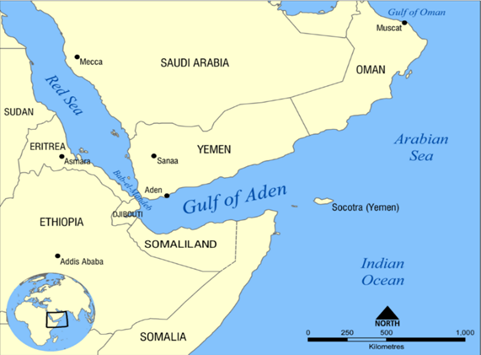
Gulf of Aden – Somalia
- The threat assessment due to “hostilities” is now considered VERY LOW, except for Israeli ships that remains MEDIUM, while it is not currently clear whether there is an escalation or de-escalation between ISRAEL-HOUTHI. There is simply a decline in attack events in accordance with the situation in the Middle East.
- Beyond the immediate military confrontation, the risks extend into the broader ideological landscape. War in the Middle East does not remain confined to battlefields as it fuels violent extremism. A drawn-out conflict would create opportunities for extremist groups to exploit, further entrenching instability in the region. Saudi Arabia categorically rejects such an outcome.
• The risk of incidents for “attempts for piracy” is VERY LOW, for now / for “Hijacking, opening fire” LOW / while for “electronic harassment of Nautical aids” is “NER”, mainly due to the current absence of incidents. Despite that the uncertainty of Somalians reactions to a situation, provides opportunities, and that creates uncertainty for the near future. A possibility for a sudden incident is larking on the sky. SEAGUARDIAN advice Shipping to take measures against piracy.
Arabian Sea – Gulf of Oman
- Threat assessment due to «actions of war» is considered MEDIUM.
- Operation Atalanta, formally European Union Naval Force (EU NAVFOR) Somalia, is an ongoing counter-piracy military operation at sea off the Horn of Africa and in the Western Indian Ocean. It is part of a larger global action by the EU to prevent and combat acts of piracy, drugs and human trafficking in the Indian Ocean, and it is the first EU naval operation to be launched.
- In the Arabian Sea and the Gulf of Oman, the risk of incidents for “attempts for piracy” is VERY LOW / for “Hijacking, opening fire” is VERY LOW / while for “electronic harassment of Nautical aids” is LOW, not due to the non-existence of the threats but mainly due to the current absence of incidents. Even if the overall assessment is LOW a refreshing on the knowledge over the Navigational aids use, is needed.
Hormuz Straits – Persian Gulf
• Threat assessment due to «actions of war» is considered HIGH.
- The existence of units and centers of operations for the security of European shipping in the region is important and it should be considered that, except in case of a total conflict involving other countries, the presence of forces under Operation AGENOR will create security conditions.
- Operation Agenor is headquartered at the French naval base in Abu Dhabi and comprises a diplomacy track (EMASoH) and a military track (AGENOR).[1] The mission has 9 participating countries including Belgium, Denmark, France, Greece, Italy, the Netherlands, Norway, and, with political support, Germany and Portugal. These are all European countries, however EMASOH is not initiated by the European Union.
- JIMC, the international press and even the management of the ships that collided in the Strait of Hormuz on June 16, state that this incident in itself is not a security violation but a SOLAS incident. SEAGUARDIAN however for the fourth time highlights the GNSS interference which is dense the last weeks in the Southern Persian Gulf that is, of course, an incident of Navigational hazard, but undermines the “unauthorized access to Satellite systems” (possibly spoofing). The chart of the area of interference and a chart with the positions of the ground stations of satellite systems in the Arabian Peninsula (details provided by IALA publications), are depicted in the following charts:
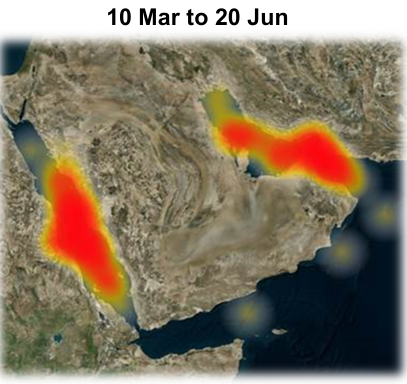

These straits are in direct monitoring the last weeks by many services and institutions. Once again SEA GUARDIAN advices the Shipping industry to focus on the transitional threats leaving aside what would be happened due to the conflict between the Israel-Iran. In retrospect, due to the consequences of this conflict which is the most important general issue, it is assessed that the “close of Hormuz straits” is possible with extraordinary methods such as sea mines. In this case the threat would be common for martial and merchant ships with of course unpredicted consequences. But the same time it will be an obstacle for the shipping for Iran. As the decision is maintained on the Iranian Security council pending, it is very pessimistic we assume the Straits closed while they are open. Another threat is the raising of insurance fees hitting a point this week while the existence of Security teams is sometimes in the precautions of them.
- In the Strait of Hormuz and the Persian Gulf, the risk of incidents for “attempts for piracy” is HIGH due to the uncertainty of the situation even there is no incidents in near past / for “Hijacking, opening fire” is “NER” / while for “electronic harassment of Nautical aids” is “HIGH” but in conjunction with the attempt of small boats with armed crew to board ships pretending official services who claim inspection rights, promoting the use of any help against traditional threats except from the threat of war.
Malacca Straits
- The hot spots in the geographical area of the SOMS (Straits of Malacca and Singapore), continue to be Pulau Karimun, near the eastern entrance to the Straits of Malacca, Pulau Cula, near Phillip Channel in the southernmost corner of the Straits Traffic Separation Scheme, and Tanjung Tondong, near the eastern entrance to the Straits of Singapore. Pirates usually operate at night and have a strong preference for targeting slow-moving cargo ships in the eastbound lane.
- All attacks are of the raid type, with a planned departure, they do not usually take hostages, they flee with whatever can be easily and quickly transported, while they attack anyone who resists or tries to hinder them while they have boarded the ship. However, the percentage of attempts in relation to the success rate in boarding is somewhat lower than in the GoG.
- The risk of incidents for “attempted piracy / maritime crime” is VERY HIGH / for “Hijacking, opening fire” is “VERY LOW” not due to the absence of a threat, but mainly the tendency not ships to be captured, but simply to rob / while for “electronic harassment of Nautical aids” is “NER”.
Piracy – Boarding conditions, hijacking, smuggling, electronic harassment
- During the last four months, two main sources of risk have emerged, the first concerns the risk of piracy resulting in the seizure of ships or the simple theft of equipment or components, which may result in injury/murder or hijacking of a crew member, and this is mainly the case. The second concerns the electronic harassment of navigational aids, creating a source of security risk that has not yet been radically addressed.
• The risks of maritime criminal acts against ships in ports or near the coast when approaching ports are mainly located in the areas of the Gulf of Guinea and the Straits of Malacca, while it is not excluded that such risks may suddenly emerge in other areas.
OVERALL ASSESSMENT – CONSULTING
• In the context of the decisions to ban third-country nationals from entering the United States, the White House is preparing a second round of bans, which includes several countries from Africa, including traditional partners such as Egypt. The reasons are related to the inability to check the validity of travel documents and identity documents, as these countries are not reliable in confirming international documents (such as passports) for their citizens who are abroad.
- Although there has been a slight increase in the number of ships passing through the Suez Canal in recent weeks, it is apparent that the provision of a transit discount is evaporating, without a steady increase in flow, since the Israel-Iran conflict broke out. SEA GUARDIAN advises shipping to reconsider the use of the Suez Canal, as the maintained data and its processing through security assessment tools show that the risk appetite is decreasing significantly, unless something suddenly changes in the Houthis’ course of action.
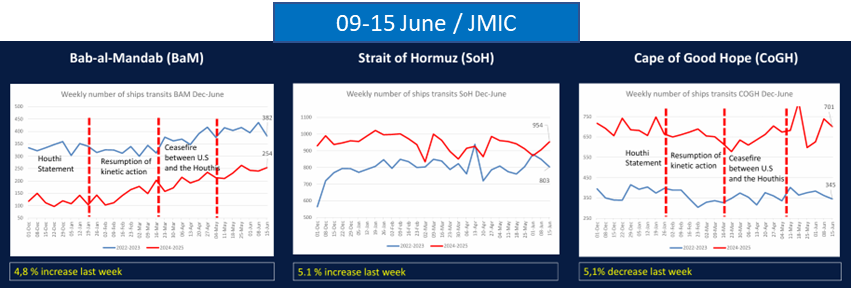
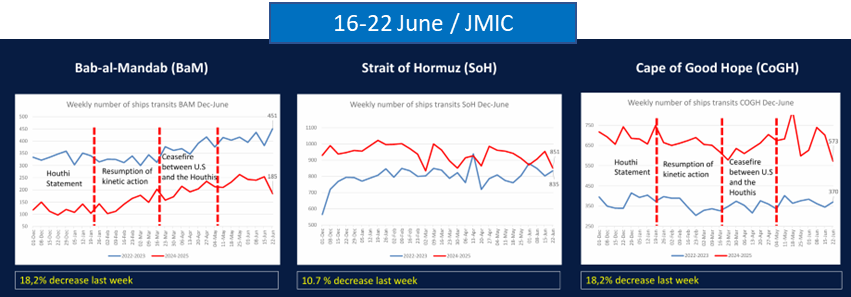
- The possibility of the uncertain area concluding Sudan-Ethiopia-Eritrea-Somalia seems to expands Southern to Kenya. It is not something for the near future but for the mid-term, which could create new threats and risks in the general vicinity of West India / Gulf of Aden.
- Israel’s attack on Iran and the subsequent reciprocal attacks have created great uncertainty. Iran does not seem to consider the Europeans as serious interlocutors in the meetings that took place last week, while on the other side of the Atlantic, Trump has approved a plan to attack Iran’s underground nuclear facilities, giving a two-week leeway from June 19, in order they find a solution through diplomacy. Additionally, it is estimated the concept of the India-Middle East-Europe Economic Corridor (IMEC) is going to be put in the long-future terms.
- Even if the world’s largest shipping associations say that some shipowners avoid the straits, for those forced to sail this waterway, it is needed to take additional measures. SEA GUARDIAN has analyzed in detail the issue of GNSS (GPS, GALILEO, GLONASS). From an operational perspective it is estimated that the problem is caused by “spoofing” tools and while all the stations are located in non-combat zones, the phenomenon exists. SEA GUARDIAN consults the double bridge duty officers, isolation of ship’s navigational aids from satellite retrofit, log speed by own measures and the use of traditional navigation, in general terms. Additionally, propose the refreshing of knowledge to through the following links: /1/G1082 Ed2.1 An Overview of AIS June 2016 /2/ EUROCONTROL Guidelines on a Process for Civil and Military GNSS Interference Testing /3/ Global Navigation Satellite System GNSS Radio Frequency Interference /4/ ICAO GNSS RFI MITIGATION PLAN
• It also appears that the ferocity of piracy attempts and boardings of ships for simple theft in the Gulf of Guinea and the Straits of Malacca, which are more frequent (3 cases in the second fortnight of June), continues.
• It is estimated that the idea of a permanent installation of an armed or unarmed group on recurring voyage charters (line charter or voyage type charter) would not be far from the reality created by the “uncertainty” in International Security. SEA GUARDIAN advises shipping industry to take measures when approaching ports in any of the areas analyzed in this SECURITY ASSESSMENT, while an attack within ports is not unlikely.
• In addition to the above, SEA GUARDIAN advises that a specific study should be made on the risks in some destinations, since the threats and risks are now multi-focal and multi-varied.
• Finally, it is obvious that the interim government in Syria will continue to seek to end the conflicts within the country by appropriately using the psychology of “normalization”, due to the focus on Israel-Iran conflict. However, it is clear that Israel has not completed its operations in South-West Syria and South Lebanon. However, the lifting of sanctions against Syria may work constructively in increasing shipping traffic in Latakia and Tartus, given that the approach to Israeli ports requires extensive formalities, even.
Usefull links for military actions and picture of piracy attacks in:ACLED and IMB/ICC.
ANNEX to this Security Threat/Risk Assessment: At the end of this assessment, SEA GUARDIAN SG LTD provides an Annex of the “Overall Risk Assessment” per area. It is the outcome of its tools, processing four domains of threats under the administration of its relative professional sections, due to the causative concern of its clients and the recipients of this assessment.
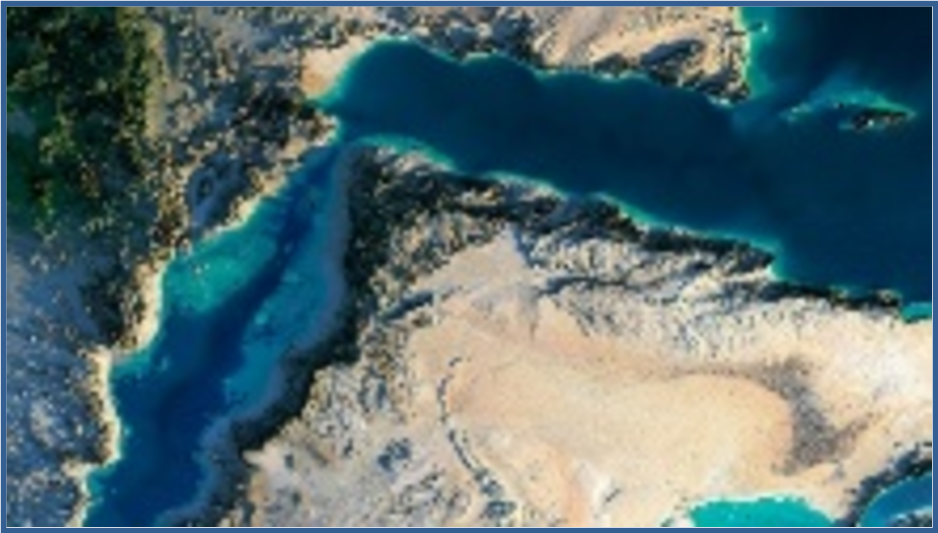
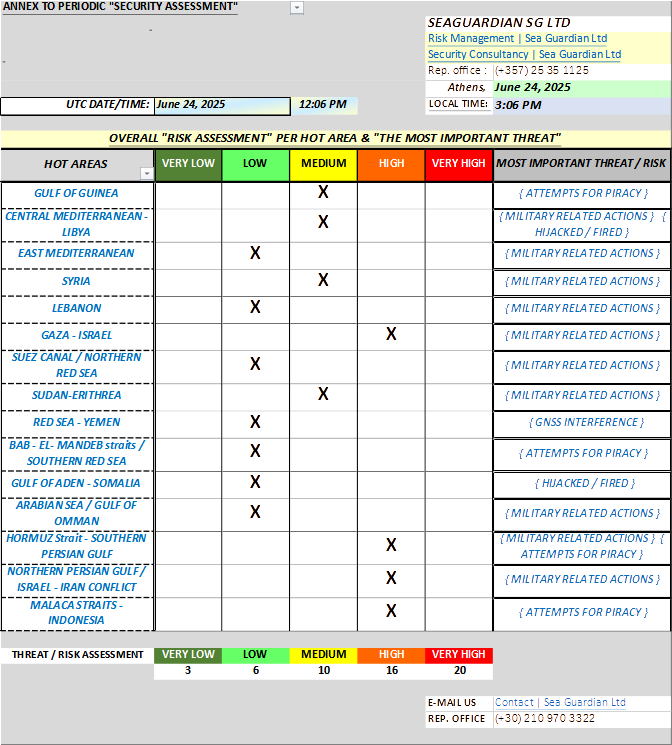
Sea Guardian S.G. Ltd / Intel Department (www.sguardian.com / +30 6944373465)
can support your operational planning, assist in determining the risk assessment and provide assistance in decision making by producing tailor-made assessments upon request
on ports in the region, on routes, on cargos and specific merchant vessels. You can refer to our previous Threat & Risk assessment analysis briefs for more information and background analysis on the events and situation in the region.
Viewers can see here below the previous report: https://allaboutshipping.co.uk/2025/06/13/sea-guardian-threat-risk-assessment-30-may-13-june-2025/ so that it’s combination with the current above makes the connection of events easier and practical given this continuation.





